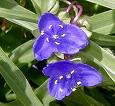 Native to North, South, and Central America, this herbaceous perennial is a member of the dayflower family, Commelinaceae, a family of 731 species. The plants grow in clumps up to 3′ tall and have tubular branched stems and narrow, arching, bright green leaves that are up to 1′ long and are angularly arranged so that they resemble a squatting spider. Unfortunately, the leaves decline by mid summer and are unsightly. From spring into summer terminal umbels of blue or purplish flowers appear. Each flower is 2″ across and has three petals and showy yellow stamens. The flowers are open only in the morning of one day and then the petals wilt and turn to jelly but so many buds are produced that the plant seems to be constantly in bloom for weeks. Virginia spiderwort is a good choice for shade, native plant, and wildlife gardens and does well in borders and naturalized areas. Plants may hybridize with other species and self seed so many different combinations of traits may appear including different flower color. The genus name, Tradescantia, honors John Tradescant (1608-1662) who served as gardener to Charles 1 of England. The specific epithet, virginiana, is the Latinized name for Virginia, a place where the plant is native.
Native to North, South, and Central America, this herbaceous perennial is a member of the dayflower family, Commelinaceae, a family of 731 species. The plants grow in clumps up to 3′ tall and have tubular branched stems and narrow, arching, bright green leaves that are up to 1′ long and are angularly arranged so that they resemble a squatting spider. Unfortunately, the leaves decline by mid summer and are unsightly. From spring into summer terminal umbels of blue or purplish flowers appear. Each flower is 2″ across and has three petals and showy yellow stamens. The flowers are open only in the morning of one day and then the petals wilt and turn to jelly but so many buds are produced that the plant seems to be constantly in bloom for weeks. Virginia spiderwort is a good choice for shade, native plant, and wildlife gardens and does well in borders and naturalized areas. Plants may hybridize with other species and self seed so many different combinations of traits may appear including different flower color. The genus name, Tradescantia, honors John Tradescant (1608-1662) who served as gardener to Charles 1 of England. The specific epithet, virginiana, is the Latinized name for Virginia, a place where the plant is native.
Type: Herbaceous perennial.
Bloom: Blue, lilac, purple, pink, white flowers in late spring-early summer for about 8 weeks total.
Size: 24” W-36” H with ever enlarging clumps.
Light: Full sun to partial shade; in most climates will bloom better and be less lanky in sun.
Soil: Average well drained but tolerates most soils .
Fertilizer: Average soil provides all that is needed.
Hardiness: Zones 4-9.
Care: Cut back when foliage becomes unattractive to encourage another bloom.
Pests and Diseases: None of importance but snails can cause leaf damage.
Propagation: Division in spring or autumn; self sows.
Companion plants: Grasses, daylilies, liriope, Siberian iris and hosta.
Outstanding Selections: ‘Zwanenburg Blue’(deep violet blue), ‘Red Cloud’ (rosey red), ‘Snowcap” (pure white), ‘J. C. Weguelin’ (light blue), ‘Isis’ (oxford blue), ‘Purple Dome’ (deep purple).

I love it – it self-sowed all up a path for me this year – never did that before. 4 ft. – yikes! For me about 18in to 2ft in close to full shade.
I’m so glad you share my enthusasum for Tradescantia. Big or small, its a reat plant for the garden.
I live in Amsterdam Holland and have a tradescantia on my balcon. It is a joy and has been flowering for years! I have a question though. I think by now it should be divided because it completely fills the pot and have very little soil left. It is now so late in the summer – almost june – and I can see the budforming. What happens if I now divide it? I do not want to lose it….I would appreciate it if you could help….
blessings
Venke
Venke,
Tradescantia are tough plants and can probably take division after flowering. When it has finished blooming, cut back to 3-4″ above the ground (I do this every year in the garden a couple of times) and divide it into several pieces, depending on how many you want and how big the mother plant is. After you divide the plant be sure to put the potted divisions in a shady place for a week or so and water them well. When they seem to be putting out new growth bring them slowly into sun. When you repot, be sure to clean the old pot well and get good fresh potting soil; one that contains a slow release fertilizer would be good.
Karen